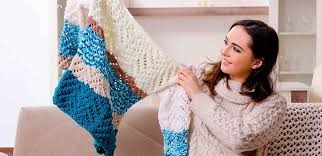How to Select the Best Yarn for Cozy Sweaters and Warm Garments

There’s nothing quite like wrapping yourself in a handmade cozy sweaters during chilly weather. Whether you’re knitting or crocheting a sweater, cardigan, or blanket, choosing the right yarn is one of the most important steps to ensure your project turns out warm, comfortable, and enjoyable to wear. But with so many yarn options available, it can be challenging to figure out what type of yarn is best for creating soft, warm garments that last.
In this guide, we’ll explore everything you need to know about selecting the best yarn for cozy sweaters and warm garments. From fiber types to yarn weight and texture, this guide will help you make informed choices that will lead to garments you can snuggle up in all winter long.
Understanding Fiber Types for Warm Garments
The fiber content of yarn plays a significant role in how warm and cozy your finished garment will be. Different fibers offer unique qualities that determine the level of softness, warmth, and elasticity your garment will have. Here are some of the best yarn fibers for creating warm garments:
Wool
Wool is often the go-to fiber for creating cozy sweaters and winter garments. It comes from sheep and is known for its ability to insulate and trap heat, making it a natural choice for warmth.
Key Benefits:
- Excellent Insulation: Wool is great at trapping air, which helps keep you warm in cold temperatures.
- Breathability: Wool is breathable, meaning it helps regulate temperature by wicking moisture away from your skin, keeping you warm without overheating.
- Elasticity: Wool’s natural stretch makes it perfect for garments that need to maintain their shape and fit comfortably.
Types of Wool to Consider:
- Merino Wool: Known for being softer than traditional wool, Merino is great for those with sensitive skin who still want the warmth and benefits of wool.
- Shetland Wool: This type of wool is a bit more rustic and sturdy, providing excellent warmth but with more texture, making it ideal for outerwear.
Best Uses: Sweaters, cardigans, shawls, and blankets.
Alpaca
Alpaca yarn is made from the fleece of alpacas and is known for being incredibly warm, even warmer than sheep’s wool. It’s a popular choice for knitters and crocheters looking to make garments that are both lightweight and cozy.
Key Benefits:
- Softness: Alpaca fibers are smooth and silky, providing a luxurious feel without the itchiness some people associate with wool.
- Hypoallergenic: Unlike wool, alpaca does not contain lanolin, making it hypoallergenic and suitable for people who may be sensitive to wool.
- Durability: Alpaca fibers are strong and long-lasting, making them ideal for creating durable garments.
Cons:
- Less Elasticity: Alpaca lacks the elasticity of wool, which means it can be prone to stretching or sagging, especially for fitted garments.
Best Uses: Ponchos, shawls, lightweight sweaters, and hats.
Cashmere
Cashmere is an ultra-luxurious fiber that comes from the undercoat of cashmere goats. It’s prized for its softness and lightweight warmth, making it a top choice for high-end winter garments.
Key Benefits:
- Supreme Softness: Cashmere is one of the softest fibers available, providing an incredibly comfortable and cozy feel against the skin.
- Lightweight Warmth: It offers a high warmth-to-weight ratio, which means it can keep you warm without being bulky.
Cons:
- Expensive: Cashmere tends to be pricey, so it’s often used for special garments or blended with other fibers to reduce cost.
- Delicate: Cashmere is delicate and requires careful washing, often needing hand-washing or dry cleaning.
Best Uses: Luxury sweaters, scarves, and wraps.
Blends
Blended yarns combine the best properties of different fibers, resulting in yarns that are versatile, affordable, and easy to work with.
Common Blends:
- Wool-Acrylic Blend: Combining wool and acrylic provides warmth while reducing cost and adding machine-washability. It’s perfect for those who want warmth without the high maintenance of 100% wool.
- Alpaca-Wool Blend: This blend offers the softness of alpaca with the elasticity of wool, making it a great choice for garments that need a bit of both.
Best Uses: Everyday sweaters, cardigans, and accessories that need warmth, comfort, and easy care.
Choosing the Right Yarn Weight
Yarn weight affects the thickness, drape, and warmth of your garment. For example, Premier Anti-Pilling Everyday Worsted Yarn from marymaxim.ca is an excellent choice for projects needing a balanced weight that ensures both warmth and a cozy feel. Here’s a guide to help you choose the right weight for a cozy winter project:
Worsted Weight (Medium, Category 4)
Worsted weight yarn is versatile and a popular choice for sweaters. It’s thick enough to create warmth but still light enough to be comfortable for everyday wear.
Benefits:
- Balanced Warmth: It provides a good level of warmth without being too bulky.
- Easy to Work With: Worsted weight is easy for beginners and experienced knitters alike, making it an ideal choice for first-time sweater projects.
Best Uses: Sweaters, cardigans, blankets, and cozy accessories.
Bulky Weight (Category 5)
Bulky yarn is thicker and creates garments that are especially warm and cozy. This yarn weight is great for creating chunky, oversized sweaters that are perfect for layering.
Benefits:
- Fast Projects: Bulky yarn knits or crochets up quickly, making it ideal if you want a fast, satisfying project.
- Extra Warmth: The thick yarn helps create heavy, insulating garments, perfect for very cold climates.
Best Uses: Chunky sweaters, oversized cardigans, thick scarves, and blankets.
DK Weight (Light, Category 3)
DK (Double Knitting) weight yarn is lighter than worsted but heavier than fingering. It’s a good choice if you’re looking for a more lightweight sweater that still provides some warmth.
Benefits:
- Versatile: It’s great for creating garments that aren’t too heavy, making it ideal for layering.
- Soft Drape: DK weight yarn creates a soft drape, perfect for fitted garments that need some flow.
Best Uses: Lightweight sweaters, cardigans, and accessories.
Yarn Texture and Ply Considerations
Smooth vs. Textured Yarn
For sweaters and other warm garments, smooth yarn is usually best. Smooth yarn creates even stitches and showcases your pattern clearly, which is especially important for beginners or if your pattern includes cables or intricate stitches.
Avoid Novelty Yarns:
- Bouclé or Eyelash Yarns: These can be difficult to work with, making it challenging to see your stitches, and they may not provide the structured warmth you need for a garment.
Best Choice:
- Choose a smooth, plied yarn that is easy to work with and creates a consistent texture in your garment.
Ply and Durability
The number of plies (strands twisted together to create the yarn) can affect the durability and texture of your garment.
- Multiple Plies: Yarns with multiple plies are generally stronger and more resistant to pilling, making them ideal for garments that will get a lot of wear.
- Single-Ply: Single-ply yarns can be soft and lovely, but they’re more prone to pilling, making them less durable for high-wear garments like sweaters.
Color and Dye Considerations
Color Choice
Darker colors tend to create a cozier look, but they can also make it harder to see your stitches, especially for beginners. Light to medium colors are easier to work with and show off your stitch pattern beautifully.
Hand-Dyed vs. Commercial Yarns
- Hand-Dyed Yarns: These often have beautiful, unique color variations, but it’s important to buy enough yarn at once to avoid dye lot differences.
- Commercial Yarns: These are more consistent, making it easier to match colors and ensure a uniform look across your entire garment.
Tips for Selecting the Best Yarn for Sweaters and Warm Garments
Consider the Pattern Requirements
Always check the yarn recommendations provided in your pattern. Designers often recommend specific yarn weights and fiber types that work best with the design’s structure, drape, and warmth.
Swatch Before Starting
Creating a gauge swatch is crucial. Different fibers and yarn weights can drastically change the look and feel of your finished garment. Swatching will help you determine if the yarn you chose matches the intended fit and texture.
Care Requirements
Consider the care needs of your yarn. Some natural fibers like wool or cashmere require hand-washing and gentle care, while acrylic blends may be machine washable. Choose a yarn that matches your lifestyle and how you plan to care for your garment.
Conclusion: Choosing the Perfect Yarn for Cozy Sweaters and Warm Garments
Selecting the best yarn for cozy sweaters and warm garments is all about finding the right balance between comfort, warmth, and practicality. Wool is the most popular choice for its warmth and elasticity, but alpaca and cashmere also offer incredible warmth and softness. Blended yarns provide versatility and are often easier to care for, making them a great choice for everyday garments.
Ultimately, the key is to consider how the yarn feels, how it will be worn, and how much care you’re willing to invest. By choosing the right yarn, you’ll create garments that are not only cozy and warm but also beautiful and built to last. Happy knitting and crocheting!



